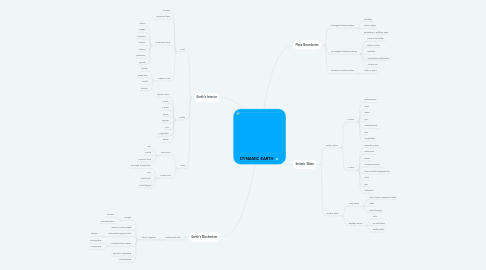
1. Earth's Interior
1.1. Crust
1.1.1. Thinnest
1.1.2. outermost layer
1.1.3. continental crust
1.1.3.1. silicon
1.1.3.2. oxygen
1.1.3.3. Aluminum
1.1.3.4. calcium
1.1.3.5. sodium
1.1.3.6. potassium
1.1.3.7. granite
1.1.4. oceanic Crust
1.1.4.1. thicker
1.1.4.2. ocean floor
1.1.4.3. basalt
1.1.4.4. heavier
1.2. Mantle
1.2.1. Silicate rocks
1.2.2. S wave
1.2.3. P wave
1.2.4. Silicon
1.2.5. Oxygen
1.2.6. iron
1.2.7. Magnesium
1.2.8. denser
1.3. Core
1.3.1. Inner Core
1.3.1.1. Iron
1.3.1.2. Nickel
1.3.1.3. 2250 km thick
1.3.2. Outer Core
1.3.2.1. very high temperature
1.3.2.2. iron
1.3.2.3. nickel melt
1.3.2.4. molten/liquid
2. Earth's Mechanism
2.1. Continental Drift
2.1.1. Alfred Wegener
2.1.1.1. Pangea
2.1.1.1.1. laurasia
2.1.1.1.2. Gondwanaland
2.1.1.2. German Meteorologist
2.1.1.3. Continental Jigsaw Puzzle
2.1.1.3.1. shapes
2.1.1.4. Evidence from Fossils
2.1.1.4.1. Glossopteris
2.1.1.4.2. Mesosaurus
2.1.1.5. Sea Floor Spreading
2.1.1.6. Coal deposits
3. Plate Boundaries
3.1. Divergent Plate Boundary
3.1.1. rift valley
3.1.2. ocean ridges
3.1.3. spreading or splitting apart
3.2. Convergent Plate Boundaries
3.2.1. Toward each other
3.2.2. Plates Collide
3.2.3. Trenches
3.2.4. Underwater Earthquakes
3.2.5. Volcanic arc
3.3. Transform Fault Boundary
3.3.1. Slide or grind
4. Seismic Wave
4.1. Body Waves
4.1.1. P wave
4.1.1.1. primary wave
4.1.1.2. solid
4.1.1.3. liquid
4.1.1.4. gas
4.1.1.5. compressional
4.1.1.6. first
4.1.1.7. longitudinal
4.1.2. S wave
4.1.2.1. secondary wave
4.1.2.2. shear wave
4.1.2.3. slower
4.1.2.4. transverse waves
4.1.2.5. back and forth perpindicular
4.1.2.6. solid
4.1.2.7. gas
4.1.2.8. latitudinal
4.2. Surface wave
4.2.1. Love waves
4.2.1.1. side to side Horizontal motion
4.2.1.2. faster
4.2.1.3. most damage
4.2.2. Rayleigh waves
4.2.2.1. rolls
4.2.2.2. up and down
4.2.2.3. earthquakes
